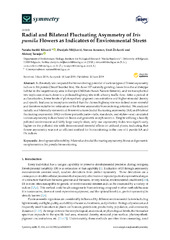Приказ основних података о документу
Radial and Bilateral Fluctuating Asymmetry of Iris pumila Flowers as Indicators of Environmental Stress
| dc.creator | Barišić Klisarić, Nataša | |
| dc.creator | Miljković, Danijela | |
| dc.creator | Avramov, Stevan | |
| dc.creator | Živković, Uroš | |
| dc.creator | Tarasjev, Aleksej | |
| dc.date.accessioned | 2019-06-24T12:48:34Z | |
| dc.date.available | 2019-06-24T12:48:34Z | |
| dc.date.issued | 2019 | |
| dc.identifier.uri | https://www.mdpi.com/2073-8994/11/6/818 | |
| dc.identifier.uri | https://radar.ibiss.bg.ac.rs/handle/123456789/3371 | |
| dc.description.abstract | In this study we compared the biomonitoring potential of various types of flower asymmetry indices in Iris pumila (Dwarf Bearded Iris). We chose 197 naturally growing clones from the arid steppe habitat in the largest sandy area in Europe (Deliblato Sands Nature Reserve), and we transplanted two replicates of each clone to a polluted highway site with a heavy traffic flow. After a period of acclimatization, lower levels of photosynthetic pigment concentrations and higher stomatal density and specific leaf area in transplants verified that the chosen highway site was indeed more stressful and therefore suitable for estimation of the flower asymmetry biomonitoring potential. We analyzed radially and bilaterally symmetrical flower structures (radial fluctuating asymmetry (RA) and bilateral fluctuating asymmetry (FA)) on three perianth parts—falls, standards, and styles—and calculated various asymmetry indices based on linear and geometric morphometrics. Despite utilizing a heavily polluted environment and fairly large sample sizes, only one asymmetry index was significantly higher on the polluted site with demonstrated stressful effects on utilized plants, indicating that flower asymmetry was not an efficient method for biomonitoring in the case of I. pumila RA and FA indices. | en |
| dc.relation | info:eu-repo/grantAgreement/MESTD/Basic Research (BR or ON)/173025/RS// | |
| dc.rights | openAccess | |
| dc.rights.uri | https://creativecommons.org/licenses/by/4.0/ | |
| dc.source | Symmetry | |
| dc.source | Symmetry | |
| dc.subject | Iris pumila | |
| dc.subject | Bilateral and radial fluctuating asymmetry | |
| dc.subject | Biomonitoring | |
| dc.subject | Developmental instability | |
| dc.subject | Linear and geometric morphometrics | |
| dc.title | Radial and Bilateral Fluctuating Asymmetry of Iris pumila Flowers as Indicators of Environmental Stress | en |
| dc.type | article | en |
| dc.rights.license | BY | |
| dcterms.abstract | Баришић Клисарић, Наташа; Миљковић, Данијела; Тарасјев, Aлексеј; Живковић, Урош; Aврамов, Стеван; | |
| dc.rights.holder | © 2019 by the authors | |
| dc.citation.issue | 6 | |
| dc.citation.volume | 11 | |
| dc.identifier.doi | 10.3390/sym11060818 | |
| dc.identifier.scopus | 2-s2.0-85068081189 | |
| dc.identifier.wos | 000475703000093 | |
| dc.citation.apa | Barišić Klisarić, N., Miljković, D., Avramov, S., Živković, U., & Tarasjev, A. (2019). Radial and Bilateral Fluctuating Asymmetry of Iris pumila Flowers as Indicators of Environmental Stress. Symmetry, 11(6), 818. | |
| dc.citation.vancouver | Barišić Klisarić N, Miljković D, Avramov S, Živković U, Tarasjev A. Radial and Bilateral Fluctuating Asymmetry of Iris pumila Flowers as Indicators of Environmental Stress. Symmetry (Basel). 2019;11(6):818. | |
| dc.citation.spage | 818 | |
| dc.type.version | publishedVersion | |
| dc.identifier.fulltext | https://radar.ibiss.bg.ac.rs//bitstream/id/5092/SymmetryBasel_2019_11_6_818.pdf | |
| dc.citation.rank | M22 |

